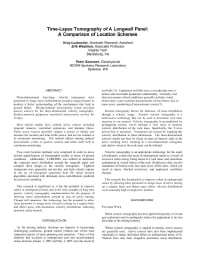Mining Publication: Time-Lapse Tomography of a Longwall Panel: A Comparison of Location Schemes
Original creation date: July 2007
Authors: KD Luxbacher, EC Westman, PL Swanson
NIOSHTIC2 Number: 20033310
Proceedings of the 26th International Conference on Ground Control in Mining, July 31 - August 2, 2007, Morgantown, West Virginia. Peng SS, Mark C, Finfinger G, Tadolini S, Khair AW, Heasley K, Luo Y, eds., Morgantown, WV: West Virginia University, 2007; :217-225
Three-dimensional time-lapse velocity tomograms were generated to image stress redistribution around a longwall panel to produce a better understanding of the mechanisms that lead to ground failure. Mining-induced microseismic events provided passive sources for the three-dimensional velocity tomography. Surface-mounted geophones monitored microseismic activity for 18 days. Most similar studies have utilized active sources including longwall shearers, controlled explosions, and hammer blows. These active sources generally require a person to initiate and measure the location and time of the source, and are not conducive to continuous monitoring. This method utilizes mining induced microseismic events as passive sources and lends itself well to continuous monitoring. Two event location methods were compared in order to move toward quantification of tomographic results in terms of ground conditions. Additionally, LAMODEL was utilized to determine the expected stress distribution around the longwa11 panel and compare these images to the velocity tomograms. Eighteen tomograms were generated, one per day, and high velocity regions in the set of tomograms generated from the initial location algorithm correlated with abutment stress redistribution predicted by numerical modeling. This research is significant as it has the potential to improve safety in underground mines and is the only example of long term passive velocity tomography implementation for the purpose of inferring stress redistribution around an area of active mining. Though still immature, this technology has the potential to allow mine personnel to image areas of active mining on a regular basis and detect areas with anomalous velocity distributions indicating potential safety hazards.

NIOSHTIC2 Number: 20033310
Proceedings of the 26th International Conference on Ground Control in Mining, July 31 - August 2, 2007, Morgantown, West Virginia. Peng SS, Mark C, Finfinger G, Tadolini S, Khair AW, Heasley K, Luo Y, eds., Morgantown, WV: West Virginia University, 2007; :217-225
- Calibration and Verification of Longwall Stress Models
- Coal Mine Safety Applications of Seismic Monitoring
- Detecting Strata Fracturing and Roof Failures from a Borehole Based Microseismic System
- Elastic and Shear Moduli of Coal Measure Rocks Derived from Basic Well Logs Using Fractal Statistics and Radial Basis Functions
- Large-Scale Strata Response to Longwall Mining: A Case Study
- Local Earthquake Tomography for Imaging Mining-Induced Changes Within the Overburden above a Longwall Mine
- Managing Ground Support for Long-Term Stability in Underground Mines
- Multiple-Seam Mining in the United States: Background
- Real-Time Hazard Recognition Using Video Gauge
- Three-Dimensional Time-Lapse Velocity Tomography of an Underground Longwall Panel